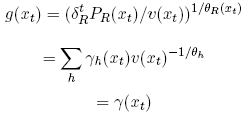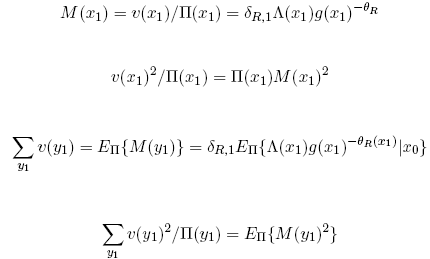This appendix contains proofs of theorems 1, 5, 7, and 8. Theorem 2 is essentially proved in the body of the paper. Theorem 3 follows directly from equation (5). Theorem 4 is proved in the body of the paper. The proof of theorem 6 is similar to the proof of theorem 5, and relies on equation (5). Additional commentary pertains to theorem 2 in Shefrin-Statman (1994), and the uniqueness of state prices.
Proof of theorem 1
The plan of the proof is to derive expressions for PR, θR, and δR, by equating two different expressions for g(xt). The first expression for g(xt) stems from the equilibrium condition

where ch is given by (4). The second expression for g(xt) stems from (5) which expresses equilibrium prices v in terms of g(xt) and the representative trader’s parameters PR, θR, and δR.
I begin the proof by defining

and

which is equivalent to the expression for (xt) that appears just before the statement of Theorem 1. Next turn to the two expressions for g(xt). The first uses (4) to compute the equilibrium value of g(xt). By definition,

and substituting for ch from (4), obtain

which, using the definition of Υh, yields

by the definition of Υ The second expression for g(xt) is obtained by inverting equation (5). Doing so yields:

Now equate the two expressions for g(xt) to obtain:

In the remainder of the proof, I use the last set of equations to establish the expressions for PR, δR, and θR that appear in the statement of theorem 1. Notice that the preceding equation, equating the two terms for g(xt), implies that:

Hence, the preceding equation defines δtR,t Pr(xt) in terms of θR. Define δtR,t as the following sum, for fixed t:

Then define Pr(xt) as the ratio

In view of the normalization implicit in the last equation,

for each t. Nonnegativity of Pr follows from the fact that all variables involved in the construction are nonnegative. With δtR,t and Pr(xt) defined in terms of θR, it remains to specify θR. In this respect, let θR be (8). Notice that (8) is a function of Π, and is derived from Benninga- Mayshar (1993). In particular, (8) is not dependent on Pr or θR. Hence there is no issue of simultaneity in determining δtR,t , Pr(xt), and θR.
The preceding argument establishes the first part of the theorem. In order to establish the nonuniqueness claim, observe that we are free to specify the function θR. Instead of choosing (8), the Benniga-Mayshar expression, we could also have set θR(xt) equal to an arbitrary constant for all xt, and solved for Pr and θR, again, as functions of θR. Equation (11) follows from (5). For sake of completeness, I sketch the proof provided by Benninga and Mayshar (1993) characterizing θR. Note that (4) and

imply that

for all xt. Based on (4), the equilibrium condition

0, and the kernel variable V = v/Π, Benninga-Mayshar define the implicit function

They note that by the principle of expected utility maximization, the representative trader’s marginal utility at C will be proportional to V . In turn, this implies that θR, the Arrow- Pratt coefficient of relative risk aversion can be defined locally by −CV 0(C)/V (C). By
computing ðF/ðC and ðF/ðV , they observe that

which, taken together with the local Arrow-Pratt measure, completes their proof. Case of log-utility: beliefs of representative trader and objective prices Consider the nature of theorem 1 in the special case when θh= 1 for all h, this being the case of log-utility. Shefrin and Statman (1994) use (3) to establish that the representative trader’s beliefs are given by the weighted sum:

and the representative trader’s normalized discount factor is:

These expressions are obtained by using (3) to equate ∑hCh(xt) and Cr(xt) to obtain the expression for Pr, and equating ∑h,xt Ch(xt) and ∑xt Cr(xt) for fixed t to obtain δ1r(t). By definition of ε and the preceding expression for Pr, obtain

so that

It follows that in order for the efficiency condition Pr(xt) = Π(xt) to hold, the sum
∑h W hεh(xt) must be zero. Define the covariance cov{∑h W hεh(xt) } by:

where

Multiplying out the terms in the covariance, yields the equivalent covariance expression:

for each xt. Recall that prices are efficient if and only if ∑h W hεh = 0 for all xt. This is equivalent to

Multiplication of this last expression by PhWh yields the equivalent condition

which implies that prices are efficient if and only if the sum of the error-wealth covariance and product of the average error and mean wealth is equal to zero.[53]
Uniqueness of state prices
Arrow and Hahn (1971) survey conditions under which the equilibrium state price vector v is unique. Their theorem 5, p. 220 establishes uniqueness for the case of homogeneous traders. More generally, their theorem 7, p. 222, establishes that equilibrium state prices are unique if the gross substitute condition holds. The gross substitute condition states that

Consider (3), the demand function for an individual trader. In this regard, note that Wh is a dot product of v and ωh. Differentiation of (3) with respect to v(yτ) yields an expression that is the sum of two terms. The first term is

and the second term is

Note that the first sum is nonnegative, and when θh = 1, the second term is zero. Summation over h leads to

. Computation reveals that the derivative is strictly positive for θh ≤ 1, and is therefore positive in an open set of 1.
Proof of theorem 5
From the perspective of xt−1, η(xt) is the future value of a contingent xt real dollar payoff. Given xt−1, the future value of a contract which delivers a certain dollar at date t must be one dollar. This is why

In other words, the future value of yt−claims are nonnegative and sum to unity. Hence they constitute a probability distribution. Since they deal with the transition from xt−1, {η(yt)} are one-step branch probabilities of a stochastic process.
Under the stochastic process, the probability attached to the occurrence of xt is obtained by multiplying the one-step branch probabilities leading to xt. To interpret this product, consider the denominator of (20). This term can be matched with the numerator of the xt−1 one-step branch probability to form

The latter term is simply one plus the single period risk free interest rate i1(xt−1) that applies on the xt−1-market. Therefore the probability of the branch leading to xt is the product of the single period stochastic interest rates and the present value of an xt-claim: i1(x0)i1(x1) ... i1(xt−1)v(xt). The product of the single period interest rates defines the cumulative return it c(xt) to holding the short-term risk-free security, with reinvestment, from date 0 to date t. A call option pays qz(xt)−K at date t,

the set of date-event pairs where the option expires in-the-money. The present value of the claims that make up the option payoff is computed using state prices v. But the present value of an xt−contingent dollar is its future value discounted back by the product of the one-period risk-free rates. The discounted contingent future dollar is simply the ratio of a risk-neutral probability η(xt) to a compounded interest rate ic(xt). Finally, the risk-neutral probability η(xt) is unconditional. To convert to a distribution conditional on exercise, divide η(xt) by Pη{AE|x0}. Using the conditional expectation in place of the unconditional expectation leads to the appearance of Pη{AE|x0} in (21).
Proof of theorem 7
To prove theorem 7, compute the first-order-condition associated with maximizing expected quadratic utility.
 (31)
(31)
where ξ is the Lagrange multiplier for the optimization and has the form:
 (32)
(32)
Next observe that

Substitution into (32) completes the proof.
Proof of theorem 8
The proof of this theorem is computational. The one-period return to the market portfolio is the sum of the date 1 dividend and date 1 price, divided by the date 0 price, i.e.

Use (7) to compute the present values two future aggregate consumption stream: the value of the unconditional process under v, and the value of the process, conditional on x1. The present value of these two streams appear respectively, in the denominator and numerator of (28), with the numerator value divided by v(x1). This completes the proof.
Prof. Hersh Shefrin
Summary: Index